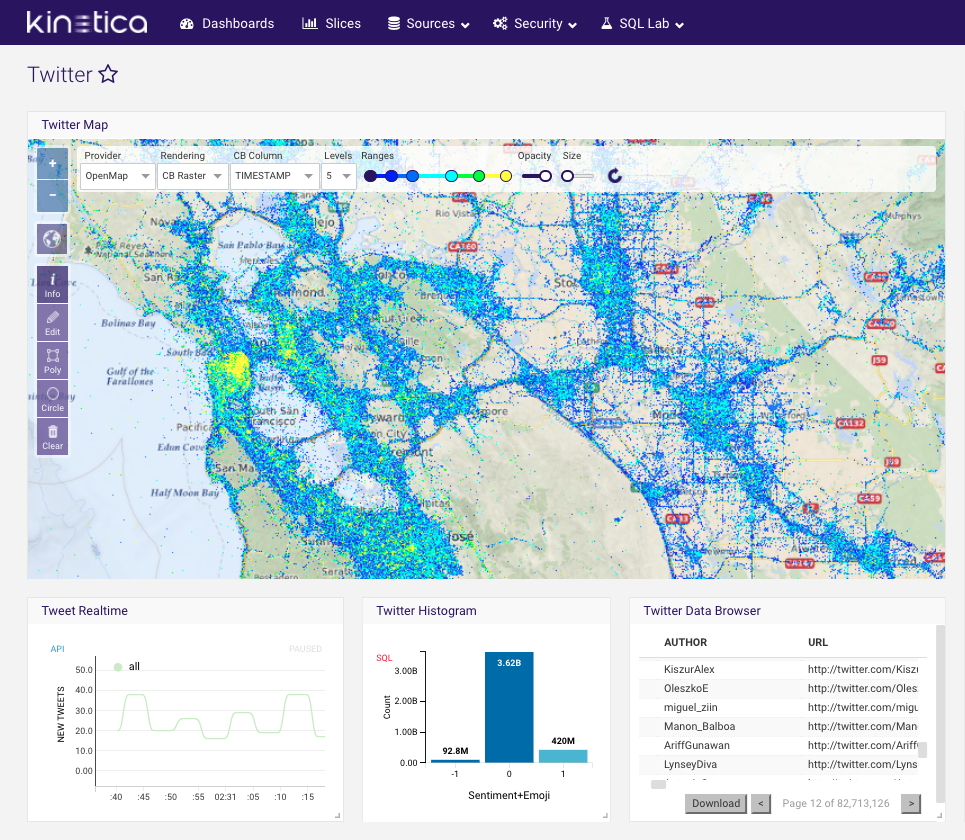 INFRA
INFRA
 INFRA
INFRA
 INFRA
INFRA
In a bid to expand the appeal of its graphics processing unit-enhanced relational database management system to large enterprises, Kinetica DB Inc. today is announcing new geospatial capabilities along with a host of enterprise-grade features such as compression, dictionary encoding, enhanced process management and enhanced security.
The company said it’s also making the product easier to install via a graphical user interface that eliminates the need for configuration files and low-level Linux commands. Users can now create a fully operational database in less than 10 minutes of machine time with a multinode cluster across machines, the company said.
Developed in 2009 for the U.S Army Intelligence and Security Command, the Kinetica engine was originally crafted to track terrorist and national security threats, a process that demanded visualizations involving large amounts of streaming data. The company said its converged platform can scale up to billions of records for online analytical processing, location-based analytics and machine learning applications.
What makes Kinetica different from most other relational engines is its use of GPUs. Originally developed for gaming applications, GPUs are increasingly being incorporated into servers as parallel processing engines. Each can each contain thousands of cores along with its own memory, enabling GPU computers to scale out to very large size for parallel processing for analytics and visualization.
GPU computers are still inching into the market, as is compatible software, but all that is changing, said Eric Mizell, vice president of global solution engineering at Kinetica. “A year ago, people were still asking what a GPU is,” he said. Thanks to an aggressive publicity campaign by Nvidia Corp., the leading GPU maker, “there are now a ton of GPU-accelerated applications hitting the market,” Mizell said. “I see GPUs almost everywhere I go now.”
The new geospatial features are a natural extension of Kinetica’s roots in geographic visualization. Previously, users had to apply mapping and visualization software from Environmental Systems Research Institute Inc. or Tableau Software Inc. to view Kinetica reports on a map. Those visualizations can now be rendered natively using the OpenGL Framework.
“ESRI uses an Oracle database under the covers and is limited to tens of thousands of points that take from minutes to hours to display,” Mizell said. “We can display billions of points in under a second.”
Uses include mapping Twitter content to location (pictured), telecommunications applications that stream call details to identify the need for new cell towers and mapping of large energy grids by utility companies, Mizell said.
The new release provides 80 geospatial functions that are exposed via SQL expressions. Spatial data management functions such as clipping, geometry splits, intersections and difference calculations, as well as spatial joins via expressions and applications program interfaces, are now also supported.
New enterprise-oriented features include compression, dynamic provisioning of new nodes and auditing for user access, security and endpoint changes. The address the most common requirements of corporate data centers, where manageability and security are paramount, Mizell said.
Compression is particularly important where large data sets are involved, and Kinetica is claiming space reductions of nearly 90 percent without performance loss. “Eighty percent of the queries go against 20 percent of the data,” he said. “We compress the data that’s rarely queried.” Users can specify their own compression parameters.
Enhanced process and node monitoring improves reliability and availability. Simplified administration and dynamic resource provisioning enable administrators to resize, add and remove nodes without downtime. Security enhancements include role mapping and database auditing per use per endpoint.
Kinetica is also making deployment to the public cloud automatic. No license prepurchase is required when using the metered offerings in Microsoft Corp.’s Azure and Amazon Web Services Inc.’s public clouds, and users can transfer their own licenses to cloud installations.
Pricing was not specified. Free 90-day trial versions will be available Oct. 31 for Ubuntu, Debian, CentOS and Red Hat Inc.’s Enterprise Linux. The trial version has no high-availability features and limited security and can only be used on a single machine.
Support our open free content by sharing and engaging with our content and community.
Where Technology Leaders Connect, Share Intelligence & Create Opportunities
SiliconANGLE Media is a recognized leader in digital media innovation serving innovative audiences and brands, bringing together cutting-edge technology, influential content, strategic insights and real-time audience engagement. As the parent company of SiliconANGLE, theCUBE Network, theCUBE Research, CUBE365, theCUBE AI and theCUBE SuperStudios — such as those established in Silicon Valley and the New York Stock Exchange (NYSE) — SiliconANGLE Media operates at the intersection of media, technology, and AI. .
Founded by tech visionaries John Furrier and Dave Vellante, SiliconANGLE Media has built a powerful ecosystem of industry-leading digital media brands, with a reach of 15+ million elite tech professionals. The company’s new, proprietary theCUBE AI Video cloud is breaking ground in audience interaction, leveraging theCUBEai.com neural network to help technology companies make data-driven decisions and stay at the forefront of industry conversations.